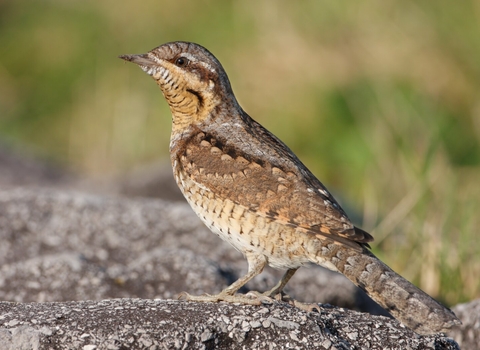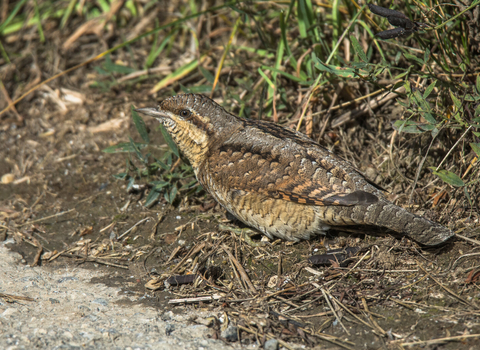
Wryneck © Rich Andrews / CVL birding

Wryneck © Pete Richman
Wryneck
This well-camouflaged woodpecker used to be a common breeding bird in Britain, but is now only likely to be seen passing through on migration.
Scientific name
Jynx torquillaWhen to see
April-May and August-OctoberSpecies information
Statistics
Length: 16-19cmWingspan: 26cm
Classed as a former breeding species under the Birds of Conservation Concern 5: the Red List for Birds (2021). Protected in the UK under the Wildlife and Countryside Act, 1981, as a Schedule 1 species.
Habitats
About
The wryneck is an unusual member of the woodpecker family. They act more like a warbler, perching on branches rather than climbing up tree trunks. They also have a smaller and weaker beak than most woodpeckers, so they nest in existing cavities instead of chiselling out their own. They mostly feed on the ground, lapping up ants with their long tongue.They nest in areas of open woodland, orchards, or even large gardens. The key features they need are cavities to nest in, open ground on which to forage, and lots of anthills. Their long tongue allows them to pull ant larvae out of the nest, and these make up a large part of their diet. Wrynecks are migrants, breeding across the higher latitudes of Europe and Asia and then heading south for the winter.
Wrynecks used to be common breeding birds across England and Wales, but the population began to decline dramatically in the 19th century. By the end of the 20th century, they were no longer breeding in England or Wales. Around this time, a small number were found breeding in Scotland, but records gradually became rarer. Now they no longer nest regularly anywhere in Britain, though the occasional attempt is recorded in Scotland.
However, wrynecks can still be seen here. Small numbers pass through on their migration between breeding grounds elsewhere in Europe and wintering grounds in Africa. They're more common in autumn than in spring, with most records coming from the south and east coasts of England.
